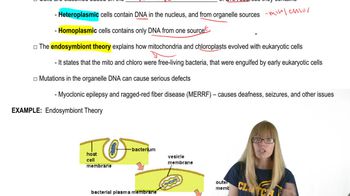Mutations in mitochondrial DNA appear to be responsible for a number of neurological disorders, including myoclonic epilepsy and ragged-red fiber disease, Leber's hereditary optic neuropathy, and Kearns-Sayre syndrome. In each case, the disease phenotype is expressed when the ratio of mutant to wild-type mitochondria exceeds a threshold peculiar to each disease, but usually in the 60 to 95 percent range.
Given that these are debilitating conditions, why has no cure been developed? Can you suggest a general approach that might be used to treat, or perhaps even cure, these disorders?
Payne, B. A. et al. (2013) present evidence that a low level of heteroplasmic mtDNA exists in all tested healthy individuals.
What are two likely sources of such heteroplasmy?
 Verified step by step guidance
Verified step by step guidance
Verified Solution
Key Concepts
Mitochondrial DNA (mtDNA)

Heteroplasmy

Sources of Heteroplasmy

Mutations in mitochondrial DNA appear to be responsible for a number of neurological disorders, including myoclonic epilepsy and ragged-red fiber disease, Leber's hereditary optic neuropathy, and Kearns-Sayre syndrome. In each case, the disease phenotype is expressed when the ratio of mutant to wild-type mitochondria exceeds a threshold peculiar to each disease, but usually in the 60 to 95 percent range.
Compared with the vast number of mitochondria in an embryo, the number of mitochondria in an ovum is relatively small. Might such an ooplasmic mitochondrial bottleneck present an opportunity for therapy or cure? Explain.
Payne, B. A. et al. (2013) present evidence that a low level of heteroplasmic mtDNA exists in all tested healthy individuals.
What genetic conditions within a given mitochondrion are likely to contribute to such a variable pool of mitochondria?
As mentioned in Section 9.3, mtDNA accumulates mutations at a rate approximately ten times faster than nuclear DNA. Thus geneticists can use mtDNA variations as a 'molecular clock' to study genetic variation and the movement of ancestral human populations from Africa to different areas of the world more than 125,000 years ago. Propose an explanation for how an analysis of mtDNA can be used to construct family trees of human evolution.
Because offspring inherit the mitochondrial genome only from the mother, evolutionarily the mitochondrial genome in males encounters a dead end. The mitochondrial genome in males has no significant impact on the genetic information of future generations. Scientists have proposed that this can result in an accumulation of mutations that have a negative impact on genetic fitness of males but not females. Experiments with Drosophila support this possibility. What experimental data or evidence would you want to evaluate or consider to determine if an accumulation of mtDNA mutations negatively impacts the fitness of males of any species?
